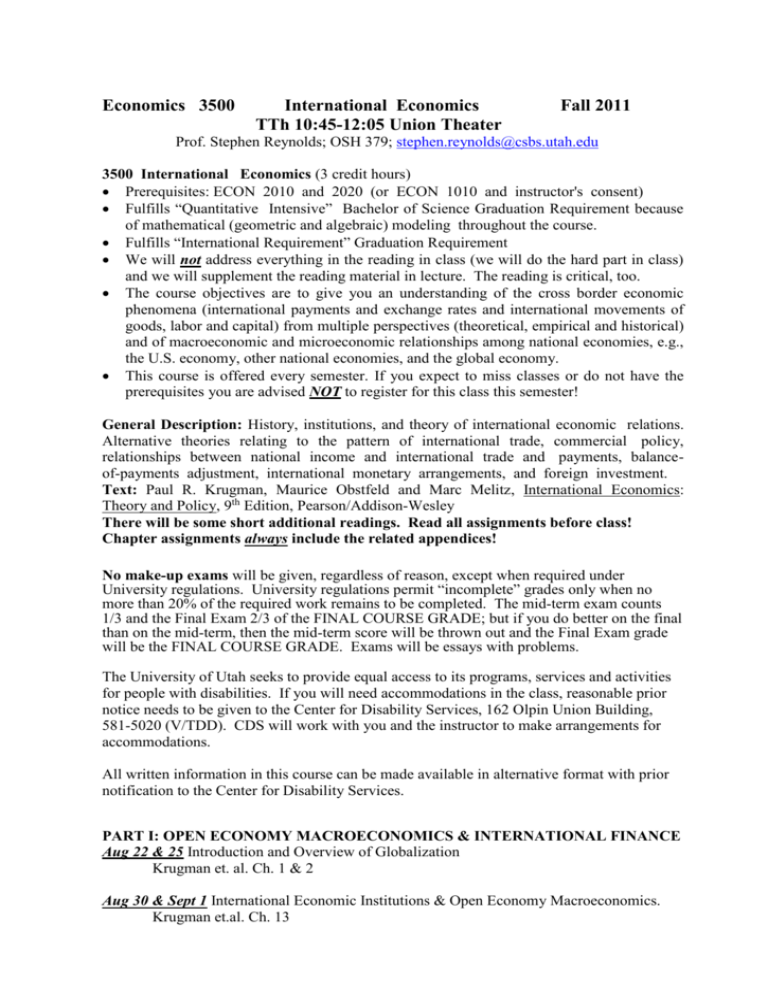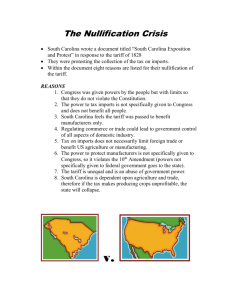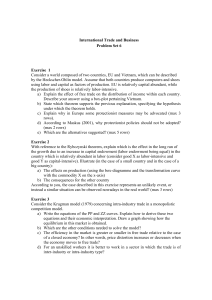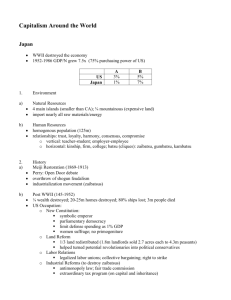
Economics 3500
International Economics
TTh 10:45-12:05 Union Theater
Fall 2011
Prof. Stephen Reynolds; OSH 379; stephen.reynolds@csbs.utah.edu
3500 International Economics (3 credit hours)
Prerequisites: ECON 2010 and 2020 (or ECON 1010 and instructor's consent)
Fulfills “Quantitative Intensive” Bachelor of Science Graduation Requirement because
of mathematical (geometric and algebraic) modeling throughout the course.
Fulfills “International Requirement” Graduation Requirement
We will not address everything in the reading in class (we will do the hard part in class)
and we will supplement the reading material in lecture. The reading is critical, too.
The course objectives are to give you an understanding of the cross border economic
phenomena (international payments and exchange rates and international movements of
goods, labor and capital) from multiple perspectives (theoretical, empirical and historical)
and of macroeconomic and microeconomic relationships among national economies, e.g.,
the U.S. economy, other national economies, and the global economy.
This course is offered every semester. If you expect to miss classes or do not have the
prerequisites you are advised NOT to register for this class this semester!
General Description: History, institutions, and theory of international economic relations.
Alternative theories relating to the pattern of international trade, commercial policy,
relationships between national income and international trade and payments, balanceof-payments adjustment, international monetary arrangements, and foreign investment.
Text: Paul R. Krugman, Maurice Obstfeld and Marc Melitz, International Economics:
Theory and Policy, 9th Edition, Pearson/Addison-Wesley
There will be some short additional readings. Read all assignments before class!
Chapter assignments always include the related appendices!
No make-up exams will be given, regardless of reason, except when required under
University regulations. University regulations permit “incomplete” grades only when no
more than 20% of the required work remains to be completed. The mid-term exam counts
1/3 and the Final Exam 2/3 of the FINAL COURSE GRADE; but if you do better on the final
than on the mid-term, then the mid-term score will be thrown out and the Final Exam grade
will be the FINAL COURSE GRADE. Exams will be essays with problems.
The University of Utah seeks to provide equal access to its programs, services and activities
for people with disabilities. If you will need accommodations in the class, reasonable prior
notice needs to be given to the Center for Disability Services, 162 Olpin Union Building,
581-5020 (V/TDD). CDS will work with you and the instructor to make arrangements for
accommodations.
All written information in this course can be made available in alternative format with prior
notification to the Center for Disability Services.
PART I: OPEN ECONOMY MACROECONOMICS & INTERNATIONAL FINANCE
Aug 22 & 25 Introduction and Overview of Globalization
Krugman et. al. Ch. 1 & 2
Aug 30 & Sept 1 International Economic Institutions & Open Economy Macroeconomics.
Krugman et.al. Ch. 13
Important key words : Balance of Trade, Balance of Payment, Current Account, Capital
Account, closed economy, open economy, macroeconomic multiplier, foreign debt, foreign
direct investment, Exchange Rates, Gold Standard, Managed Flexibility of Exchange Rate,
the IMF, the Bretton Woods System, Special Drawing Rights, Exchange Control, Eurodollar,
Oil crisis and Oil payments, GATT and WTO, trade liberalization and financial liberalization,
European Monetary System, debt crisis, Asian economic crisis, U.S. recession.
Sept 6 Currency Exchange Rates & the Foreign Exchange Market
Krugman et.al. Ch. 14
Important key words: The supply and demand for foreign exchange, exchange market
intervention regimes, the Bretton Woods Arrangements, nominal effective exchange rate,
real effective exchange rate, forward exchange markets, revaluation and devaluation,
appreciation and depreciation, specie flow mechanism.
Sept 8 Money, Interest Rates and Exchange Rates
Krugman et.al. Ch. 15
Sept 13 Price Levels and the Exchange Rate in the Long Run
Krugman et.al. Ch. 16
Sept 15 Output and the Exchange Rate in the Short Run
Krugman et.al. Ch. 17
Sept 20 Fixed Exchange Rates & Government Exchange Market Intervention
Krugman et.al. Ch. 18
Sept 22 International Monetary Systems
Krugman et.al. Ch. 19
Sept 27 Optimum Currency Areas, European Monetary Union & the Euro
Krugman et.al. Ch.20
Sept 29 Financial Globalization
Krugman et.al. Ch 21
Oct 4
Developing Countries: Macroeconomic Growth and Crisis
Krugman et.al. Ch. 22
Oct 6 Developed Countries: Macroeconomics Crisis and Policy
Assignments Forthcoming
Oct 8-16 Fall Break– No Classes
Oct 18 Class Review for midterm-exam
All Assignments to Date
Oct 20 One hour midterm exam!
PART II: THE PATTERN OF TRADE AND TRADE POLICY
Oct 25 Determinants of the Pattern of Trade: Classical Theory
Krugman et.al. Ch. 1, 2 & 3
Important key words:
Absolute advantage , comparative advantage, reciprocal demand, terms of trade, gain
from trade, international trade with constant costs and increasing costs, offer curves,
opportunity cost, production possibility curve, community indifference curves,
equilibrium in a closed economy, equilibrium before and after trade, pre-trade
equilibrium, post-trade equilibrium.Balance of Trade and Balance of Payments;
A basis for trade : International trade theories
Oct 27 Determinants of the Pattern of Trade: Specific Factors
Krugman and Obstfeld Ch. 4
Nov 1 & 3 The Factor (Resources) Proportions Theory & Modifications
Krugman et.al. Ch. 5 & 6
Important key words :
Factor proportions, Heckscher-Ohlin theorem, factor endowment, equalization of factor
prices, welfare economics of trade, factor movements, production function, factor
intensity, factor reversal, box-diagram and production possibility curve, product cycle,
economy of scale, intra-industry trade, border trade, effect of economic growth on trade,
immiserizing growth, transport costs, gravity model.
Nov 8 Increasing Returns & Location of Production
Krugman et.al. Ch. 7
Nov 10 Multinational Enterprise
Krugman et.al. Ch. 8
Nov 15 & 17 Instruments of Trade Policy
Krugman et.al. Ch. 9
Important key words:
Tariff protection, non-tariff protection, effective tariff, value added, dumping, cartels,
international aspects of environmental economics, quota, voluntary export restraint,
retaliation, export subsidies, terms-of-trade argument, infant-industry argument,
protection to correct distortion.
Nov 22 Political Economy of Trade Policy
Krugman et.al. Ch. 10
Nov 24 Thanksgiving Holiday – No Class
Nov 29 Trade policy and Economic Development
Krugman et.al. Ch. 11
Dec 1
Is Free Trade Really the Best Policy
Krugman et.al. Ch. 12
Dec 6 All Course Review: Trade and Trade Policy
Dec 8 All Course Review: Open Economy Macroeconomics & Policy
Dec 16 10:30am-12:30pm Two hour final exam!
Selected Key Words:
Part I.
( from Dominick Salvatore, International Economics, 6 th edition, Prentice Hall International, Inc. 1998.)
Balance of Payments. -A summary statement of all international transactions of the residents of a nation
with the rest of the world during a particular period of time, usually a year.
Credit transactions. -Transactions that involve the receipt of payments from foreigners. These include the
export of goods and services, unilateral transfers from foreigners, and capital inflows.
Debit transactions. -Transactions that involve payments to foreigners. These include the import of goods
and services, unilateral transfers to foreigners, and capital transfers.
Current account. -The account that includes all sales and purchases of currently produced goods and
services, income on foreign investments, and unilateral transfers.
Autonomous transactions. -International transactions that take place for business or profit motives (except
for unilateral transfers) and independently of balance-of-payments consideration; also called above-the-line
items.
Accommodating transactions. -Transactions in official reserve assets required to balance international
transactions; also called below-the-line items.
Capital account. -The change in U.S. assets abroad and foreign assets in the Unite States, other than
official reserve assets.
Open-economy macroeconomics. -The study of foreign exchange markets, the balance of payments and
adjustment to balance-of-payments disequilibria
Hedging. -The avoidance of a foreign exchange risk (or covering of an open position)
Speculation. -The acceptance of foreign exchange risk, or open position, in the hope of making a profit.
Exchange rate. -The domestic currency price of the foreign currency.
Cross exchange rate. -The exchange rate between currency A and currency B, given the exchange rate of
Forward rate. -The exchange rate in foreign exchange transactions involving delivery of the foreign
exchange one, three, or six months after the contract in agreed upon.
Foreign exchange futures. -A forward contract for standardized currency amounts and selected calendar
Dates traded on an organized market (exchange).
Gold standard. A monetary system in which governments or central banks maintain a fixed price of gold
in terms of their currencies by offering to purchase or sell gold at fixed local currency prices. Exchange
rates are then determined by relative national prices of gold.
Bretton Woods system. --The gold-exchange standard that operated from the end of World War II until
1971.
Devaluation. -A deliberate (policy) increase in the exchange rate by a nation's monetary authorities from
one fixed or pegged level to another.
Depreciation. -An increase in the domestic currency price of the foreign currency.
Appreciation. -A decrease in the domestic currency price of the foreign currency.
Foreign exchange reserves. Foreign financial assets held by a government or central bank which are
available to support the country's balance of payments or exchange rate. Includes holding of gold, the
country's reserve position in the International Monetary Fund, and claims on foreign government and
central banks.
Marshall-Lerner condition. -Indicates that the foreign exchange market is stable when the sum of the
price elasticities of the demands for imports and exports is larger than 1.
J-curve effect. -The deterioration before a net improvement in a country's trade balance resulting from a
depreciation or devaluation.
Monetary approach to the balance of payments. -The approach that views the balance of payments as
an essentially monetary phenomenon with money playing the key role in the long run as both the cause
and the cure of balance-of-payments disequilibria or in determining exchange rates.
Freely floating exchange rate system. -The flexible exchange rate system under which the exchange rate
is always determined by the forces of demand and supply without any government intervention in
foreign exchange markets.
Exchange market intervention. Purchase of sales of foreign exchange by a central bank which are
intended to maintain a fixed exchange rate or to affect the behavior of a floating rate.
Crawling peg system. -The system under which par values or exchange rates are changed by very
small pre-announced amounts at frequent and clearly specified intervals until the equilibrium exchange
rate is reached.
Managed or dirty floating exchange rate. A policy in which a government or central bank does not
maintain a parity and instead allows the exchange rate to change to some degree with market forces.
The behavior of the market. Such intervention is intended to produce exchange market behavior which
the government prefers.
Par value. A fixed exchange rate, denominated in terms of a foreign currency or gold.
Purchasing power parity. The argument that the exchange for two currencies should reflect relative price
levels in the two countries. If yen prices in Japan are on the average 200 time as high as dollar prices
in the United States, the exchange rate should be 200 yen = $1.Associated with Gustav Cassel.
Part II. ( from Dominick Salvatore, International Economics, 6 th edition, Prentice Hall International, Inc.
1998.)
Absolute Advantage. The argument, associated with Adam Smith, that trade is based on absolute
differences in cost. Each country will export those products for which its costs, in terms of labor and other
inputs, are lower than costs in other countries.
Comparative Advantage. The argument, associated by David Ricardo in the early nineteenth century, that
mutually beneficial balanced trade is possible even if one country has an absolute advantage in both goods.
All that is required is that there be a difference in the relative costs of the two goods in the two countries
and that each country export the product for which it has relatively or comparatively lower costs.
Heckscher-Ohlin theorem. The argument, developed by two Swedish economists in the 1920s, that
international trade patterns are determined by the fact that countries have different relative factor inputs.
Each country will export those products that require a great deal of its relatively abundant factor of
production.
Factor Price Equalization. The argument that international trade that is based on differences in relative
factor endowments, as predicted by the Heckscher-Ohlin, will tend to reduce or eliminate international
differences in factor prices.
Stolper-Samuelson theorem. The argument that in a world of Heckscher-Ohlin trade, free trade will reduce
the income of the scarce factor of production and increase the income of the abundant factor of production
in each country. Under rather demanding assumptions, wage rates will be equalized across countries, as
will returns to capital.
Relative factor endownments. The relative amounts of different factors of production which two countries
have. India has a relative abundance of labor, while the United States has a greater relative abundance of
capital.
Relative factor intensities. The relative amounts of different factors of production that are used in the
production of two goods. Textiles and garments are relatively labor intensive, whereas oil refining is
relatively capital intensive.
Factor intensity reversal. A situation in which it is impossible to rank clearly or identify the relative factor
intensities of two products, because one is more labor intensive at one set of relative factor prices, but the
other becomes more labor intensive at another set of relative factor prices. Factor intensity reversal can
occur when it is far easier to substitute one factor for the other in one industry than it is in the other industry.
Terms of trade. The ratio of a country's export prices to its import prices. High terms of trade imply large
welfare benefits from trade.
Offer curve. A curve that illustrates the volume of exports and imports that a country will choose to
undertake at various terms of trade. Also known as a reciprocal demand curve.
Leontief paradox. The 1953 research findings by Wassily Leontief that U.S. exports were more labor
intensive that U.S. imports, which contradicts the predictions of the Heckscher-Ohlin theorem.
Immiserizing growth. Economic growth that is so strongly biased toward the production of exports, and
where the world demand for these exports is so price ineladtic, that the world price falls sufficiently to leave
the country worse off than it was before the growth occurred.
Rybczynski theorem. The argument, associated with Thomas Rybczynski, that if the supply of one factor
of production increases, when both relative factor and goods prices are unchanged, the output of the
product using that factor intensively will increase and the output of the product using the other factor of
production intensively must decline.
Vernon product cycle. The observation that a country such as the United States will frequently export a
product that it has invented only for as long as it can maintain a technical monopoly. When the technology
becomes available abroad, perhaps because a patent has expired, production grows rapidly in foreign
countries where costs are lower, and the inventing country experiences a decline in its production of the
product because of a repid growth of imports.
Mercantilism. The view that a government should actively discourage imports and encourage exports, as
well as regulate other aspects of the economy.
Commercial policy. Government policies that are intended to change international trade flows, particularly
to restrict imports.
Cartel. A Collusive arrangement among sellers of a product in different countries, which is intended to
raise the price of that product in order to extract monopoly rents.
Nontariff barrier. Any government policy other than a tariff which is designed to discourage imports in
favor of domestic products. Quotas and government procurement rules are among the most important
nontariff trade barriers.
Quota. A government policy that limits the physical volume of a product which may be imported per
period of time.
Effective tariff. A measurement of the amount of protection provided to an industry by a tariff schedule
which allows for tariffs on inputs that industry buys from others, as well as for the tariffs on the output
of the industry. The effective tariff can be negative, which means that the government policy is
discriminating against local firms and in favor of imports, if tariff levels on inputs are sufficiently higher
than the tariff on the final good.
Ad valorem tariff. A tariff that is measured as a percentage of the value of the traded product.
Specific tariff. A tariff that is measured as a fixed amount of money per physical unit imported--$500 per
car or $10 per ton, for example.
Dumping. Selling a product in an export market for less than it sold for in the home market or for less than
the importing country views as a fair value, which is usually based on estimates of average cost.
Predatory dumping. Temporary dumping designed to drive competing firms out of business in order to
create a monopoly and raise prices.
Countervailing duty. A tariff imposed by an importing country which is intended to increase the price of
the goods to a legally defined fair level. Often used in export subsidy and dumping cases.
Voluntary Export Restraint (VER). A way of maintaining a quota by evading the GATT prohibition on
such quantitative limits. The exporting country agrees to maintain limits on its sales, frequently in order to
avoid a more damaging protectionist policy by the importing country. Sometimes known as an Orderly
Marketing Agreement (OMA). VERs are to be removed under the recently completed Uruguay Round
agreement.
Optimum tariff. A tariff that is designed to maximize a large country's benefits from trade by improving its
terms of trade. Optimum only for the country imposing the tariff, not for the world.
Import substitution strategy. A development policy in which economic growth is to be encouraged by
repressing imports and by encouraging the domestic production of substitutes for those imports.
Infant-industry protection. The argument that an industry's costs will be high when it is beginning, and it
will therefore need protection from imports to survive. If provided with a period of protection, the
industry's cost will decline and it will be able to prosper without protection.
Export-led growth. Policies in developing countries that are designed to encourage economic growth
which is based on rapid growth of exports sales. Widely used in East Asian countries.
Free-trade zone. An area within a nation where manufacturing can be carried out with imported parts and
components on which no tariffs have been paid. The output of such manufacturing efforts must then be
exported if it is to remain duty free. Many developing countries have free-trade zones, which are also
known as duty-free zones, as a way of encouraging export activities, which require import inputs, without
eliminating protection for domestic industries that produce such inputs for the rest of the economy.
Intraindustry trade. Trade that occurs when a country both exports and imports the output of the same
industry. Italy exporting Fiat automobiles to Germany and importing VWs from Germany would be and
example of intraindustry trade.
Singer-Prebisch hypothesis. The argument developed by Hans Singer and Raul Prebisch that developing
countries face a secular decline in their terms of trade owing to a trend toward lower prices for primary
commodities relative to prices of manufactured goods.
Brain drain. The movement of scientists, engineers, and other highly educated people from developing to
industrialized countries, which imposes a loss of public investment in education on the developing countries.
Transfer pricing. The practice of using false or misleading prices on trade documents in order to evade ad
valorem tariffs or exchange controls, or to shift profits within a multinational firm from a high tax rate
jurisdiction to a low tax rate jurisdiction. Also known as false invoicing.
Free-trade area. A group of countries that maintain free trade among the membership, but where each
country maintains its own tariff schedule for trade with nonmembers.
Customs union. A group of countries that maintain tree trade in goods among the membership and a
common external tariff schedule.
Economic union. An agreement among a group of countries to maintain free trade among themselves, a
common external tariff, mobility of capital and labor among the members, and some degree of
unification in their budgetary and monetary systems.
Trade creation. An efficiency gain that results from the operation of a free-trade area because more
efficient firms from a member country displace less efficient local producers in the domestic market.
Trade diversion. An efficiency loss that results from the operation of a free-trade area because less
efficient firms from a member country displace more efficient producers from a nonmember country.
It occurs because of the discriminatory nature of the tariff regime. The member country faces no tariff
in the import market, whereas the nonmember still faces a tariff.
Generalized System of Preferences. A preferential trading arrangement in which industrialized countries
allow tariff-free imports from developing countries while maintaining tariffs on the same products from
other industrialized countries.
Deadweight loss. The loss from a tariff or other restrictive policy that is a gain to nobody. A pure
efficiency loss.
Arbitrage. Purchase of a good or an asset in a low-price market and its riskless sale in a higher price
market. If arbitrage is possible, prices should be forced together, differing by no more than transport or
transactions costs.
Embargo. A complete prohibition of trade with a country. U.S. trade with Libya and Cuba, for example,
is under an embargo.
Escape clause. A provision of U.S. law which allows temporary protection for U.S. industries that are
under particular pressure from imports.
Law of the second best. The argument associated with Richard Lipsey and Kelvin Lancaster, that when
an economic distortion exists which cannot be removed, government intervention may be necessary to
minimize the losses resulting that distortion. Many arguments for protection are example of this law.
Multi-Fibre Arrangement (MFA). A system of bilateral quotas in the markets for textiles and garments in
which each exporting country is allowed to send a specified quantity of various textiles or garment products
to an importing country per year.






